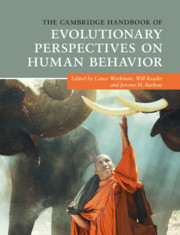Book contents
- The Cambridge Handbook of Evolutionary Perspectives on Human Behavior
- The Cambridge Handbook of Evolutionary Perspectives on Human Behavior
- Copyright page
- Dedication
- Contents
- Figures
- Tables
- Contributors
- Preface
- Acknowledgments
- Part I The Comparative Approach
- 1 Human–Grey Parrot Comparisons in Cognitive Performance
- 2 Cognitive Abilities in Elephants
- 3 Culture and Communication among Cetaceans
- Part II Sociocultural Anthropology and Evolution
- Part III Evolution and Neuroscience
- Part IV Group Living
- Part V Evolution and Cognition
- Part VI Evolution and Development
- Part VII Sexual Selection and Human Sex Differences
- Part VIII Abnormal Behavior and Evolutionary Psychopathology
- Part IX Applying Evolutionary Principles
- Part X Evolution and the Media
- Index
- References
1 - Human–Grey Parrot Comparisons in Cognitive Performance
from Part I - The Comparative Approach
Published online by Cambridge University Press: 02 March 2020
- The Cambridge Handbook of Evolutionary Perspectives on Human Behavior
- The Cambridge Handbook of Evolutionary Perspectives on Human Behavior
- Copyright page
- Dedication
- Contents
- Figures
- Tables
- Contributors
- Preface
- Acknowledgments
- Part I The Comparative Approach
- 1 Human–Grey Parrot Comparisons in Cognitive Performance
- 2 Cognitive Abilities in Elephants
- 3 Culture and Communication among Cetaceans
- Part II Sociocultural Anthropology and Evolution
- Part III Evolution and Neuroscience
- Part IV Group Living
- Part V Evolution and Cognition
- Part VI Evolution and Development
- Part VII Sexual Selection and Human Sex Differences
- Part VIII Abnormal Behavior and Evolutionary Psychopathology
- Part IX Applying Evolutionary Principles
- Part X Evolution and the Media
- Index
- References
Summary
Animal cognition is, by itself, an incredibly broad field, encompassing a huge variety of taxa and involving many different topics in both the laboratory and nature. When asked to view the field through the lens of an evolutionary perspective relative to humans, most scientists focus on our nearest relatives, the great apes (e.g., note the preponderance of chapters devoted to nonhuman primates in Vonk & Shackelford, 2012). Convergent evolution, however, provides striking insights into how distantly related species have responded to similar social and ecological challenges, and comparisons between avian and primate species have demonstrated remarkable parallels in various capacities (Emery & Clayton, 2004; Pepperberg, 1999, 2013). In areas such as vocal learning, avian species, separated from humans by over 300 million years of evolution (e.g., Hedges et al., 1996), actually provide a better model for study than do apes (e.g., Bolhuis & Everaert, 2013; Chakraborty et al., 2015).
- Type
- Chapter
- Information
- Publisher: Cambridge University PressPrint publication year: 2020



